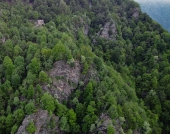I am working on a piece of property that has some unique challenges as well as advantages. The advantages include south-facing slope at just the right angle to take full advantage of the winter sun, well water, it's situated on the lower half of a hill, cold air moves off the property easily, and it has good drainage (too good, actually). The disadvantages include no cation exchange capacity (we'll be making massive amounts of
compost), sandy/gravelly soil that goes down at least 75 feet, little rain (~11"/year), no water retention, and a steep slope (the property is 2/3 of an acre and has an elevation change of 32 feet from the top of the property to the bottom with the top half being the steepest). The top 1/3 is intended for orchard and poultry and it seems that terracing would be the best option to make the land workable, to retain water, to add organic matter, to prevent frost pockets, etc. But how stable would it be, particularly if we had a sizeable water event (I'm from Seattle, so this is relative in relation to the Boise area) or an earthquake, which is very infrequent but inevitable (the last one was in 1983). Also, how could we help minimize the damage from the hilltop above the property sliding down to this property (trees, shrubs, and herbaceous plants with taproots and fibrous roots planted along the top border come to mind). Would I need to terrace the entire area or just create terraced wells where the fruit trees are planted? Any ideas would be greatly appreciated.







